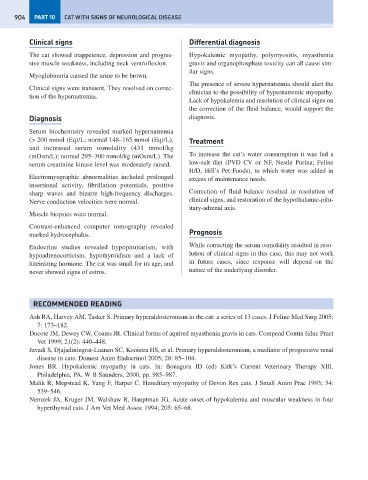Page 912 - Problem-Based Feline Medicine
P. 912
904 PART 10 CAT WITH SIGNS OF NEUROLOGICAL DISEASE
Clinical signs Differential diagnosis
The cat showed inappetence, depression and progres- Hypokalemic myopathy, polymyositis, myasthenia
sive muscle weakness, including neck ventroflexion. gravis and organophosphate toxicity can all cause sim-
ilar signs.
Myoglobinuria caused the urine to be brown.
The presence of severe hypernatremia should alert the
Clinical signs were transient. They resolved on correc-
clinician to the possibility of hypernatremic myopathy.
tion of the hypernatremia.
Lack of hypokalemia and resolution of clinical signs on
the correction of the fluid balance, would support the
Diagnosis diagnosis.
Serum biochemistry revealed marked hypernatremia
(> 200 mmol (Eq)/L; normal 148–165 mmol (Eq)/L), Treatment
and increased serum osmolality (431 mmol/kg
(mOsm/L); normal 295–300 mmol/kg (mOsm/L). The To increase the cat’s water consumption it was fed a
serum creatinine kinase level was moderately raised. low-salt diet (PVD CV or NF, Nestlé Purina; Feline
H/D, Hill’s Pet Foods), to which water was added in
Electromyographic abnormalities included prolonged excess of maintenance needs.
insertional activity, fibrillation potentials, positive
sharp waves and bizarre high-frequency discharges. Correction of fluid balance resulted in resolution of
Nerve conduction velocities were normal. clinical signs, and restoration of the hypothalamic-pitu-
itary-adrenal axis.
Muscle biopsies were normal.
Contrast-enhanced computer tomography revealed
marked hydrocephalus. Prognosis
Endocrine studies revealed hypopituitarism, with While correcting the serum osmolality resulted in reso-
hypoadrenocorticism, hypothyroidism and a lack of lution of clinical signs in this case, this may not work
luteinizing hormone. The cat was small for its age, and in future cases, since response will depend on the
never showed signs of estrus. nature of the underlying disorder.
RECOMMENDED READING
Ash RA, Harvey AM, Tasker S. Primary hyperaldosteronism in the cat: a series of 13 cases. J Feline Med Surg 2005;
7: 173–182.
Ducote JM, Dewey CW, Coates JR. Clinical forms of aquired myasthenia gravis in cats. Compend Contin Educ Pract
Vet 1999; 21(2): 440–448.
Javadi S, Djajadiningrat-Laanen SC, Kooistra HS, et al. Primary hyperaldosteronism, a mediator of progressive renal
disease in cats. Domest Anim Endocrinol 2005; 28: 85–104.
Jones BR. Hypokalemic myopathy in cats. In: Bonagura JD (ed) Kirk’s Current Veterinary Therapy XIII.
Philadelphia, PA, W B Saunders, 2000, pp. 985–987.
Malik R, Mepstead K, Yang F, Harper C. Hereditary myopathy of Devon Rex cats. J Small Anim Prac 1993; 34:
539–546.
Nemzek JA, Kruger JM, Walshaw R, Hauptman JG. Acute onset of hypokalemia and muscular weakness in four
hyperthyroid cats. J Am Vet Med Assoc 1994; 205: 65–68.

